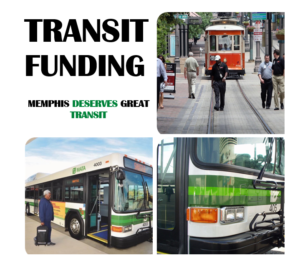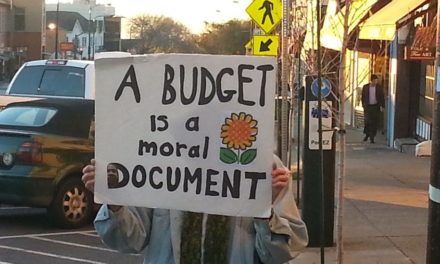My grandmother often answered our latest whining request with the response: “if wishes were horses, beggars would ride.” The updated version for our community: If talk was money, MATA would have light rail to Somerville.
Either way, the message is the same. Talk is cheap.
Unfortunately, that’s not true when it comes to public transit. Rather, the cost of talk and no action is profound.
There is the necessity to buy a car when money would be better spent on other things. There is the economic drag caused by the lack of connections to job centers. There is the larger carbon footprint and threats to ozone attainment resulting from more cars on the road. Then again, there are the many negative consequences associated with a car-centric lifestyle and policies.
And The Public Shall Lead Us
Improving public transit is an issue on which the public leads.
For the past 20 years (at least), the public has been calling for better transit and more funding to make it happen. There was a call to action in 2008 with recommendations in Sustainable Shelby, the public said in scientific polling in Sustainable Shelby and City of Memphis Five-Year Strategic Plan in 2011 that they want more funding to be spent on making neighborhoods more livable and the city more successful – and effective public transit lay at the heart of achieving both.
Better transit has already surfaced often as a priority in the first community meetings for Memphis 3.0, and the public is saying it again right now in the survey being conducted by Innovate Memphis in the wake of the release of its report filling the information vacuum that regularly is missing in discussions about public transit and Memphis Area Transit Authority.
The Mandate
You can still participate in the survey here, but so far, the mandate is clear:
* 77% support a movement to provide MATA with a dedicated funding source – only 3% oppose it.
* 76% say increased access to jobs is the top outcome for supporting public transit funding; 76% say regional economic benefits, and 71% said improved quality of life.
* The top reasons people said they drive alone is because they need a car for their work and transit service is not convenient.
* The most important factors that people say would encourage them to use public transit are accessibility, service from home to work, and safety.
* The biggest barrier to ridership is that Memphians are looking for more home to work service.
Stepping Out
For several years, Innovate Memphis – which was the Mayor’s Innovation Delivery Team during the administration of Mayor A C Wharton – has been leading the research and discussion about public transit. Suzanne Carlson was hired as transportation and mobility project manager and moved from Chicago where she was providing advice to the Chicago Department of Transportation.
The good news is the Innovate Memphis report was also sponsored by the Greater Memphis Chamber, which, under its present leadership, is willing to step out front on issues that the business group would have traditionally given only lip service, if not avoided, in the past. In addition, Innovate Memphis assembled a “transit funding working group” (disclosure: we were part of it) that also included activists, neighborhood groups, and others.
A broader understanding of what makes Memphis economically successful is key to our ability to find permanent solutions to MATA’s funding challenges. And make no mistake about it, the chief reason that Memphis and Shelby County’s public transit is not better is simple – money.
The need is clear: In the ranking of public transit in 72 cities with populations of more than 250,000, Memphis ranks #55, and among the 32 cities with populations of more than 500,000, Memphis ranks #27, according to the highly respected Center for Neighborhood Technology, whose recommendations for the Blueprint for Prosperity, the plan to reduce poverty by 10 points in 10 years, keyed on public transit.
The Hurdles
To underscore the dimensions of our community’s need, consider that only about 12% of the jobs in the region are within a 30-minute public transit trip. Within a half-mile of transit, there are 213,000 commuters, and yet, only 2.3% of commuters use MATA.
Meanwhile, 170,000 fewer people live within the 1970 Memphis city limits – a decline of 27%; annexation increased land 55% while population only increased 4%; population density is down almost 50%; 12% of jobs are in the Central Business District, ranking Memphis as one of three cities with the lowest employment in its core, and nearly 50% of jobs are 10 to 35 miles out and farthest from poor residents.
It’s often said that all politics is local, and that is likely to be more and more the case with funding for public transit. Already, a draft proposal of the Republican budget for the federal government includes cuts – and possibly a phase out – of funding for public transportation systems.
In Nashville, Governor Bill Haslam lobbies for an increase in the gas tax to fund infrastructure improvements. That the definition of infrastructure regularly does not include public transit speaks volumes on how far we have to go, and while there are Democratic proposals to peel off part of the gas tax increase for urban public transit, their influence is modest compared to the massive lobbying machine that is the Tennessee Roadbuilders Association.
All Politics Is Local
Federal funding for operations peaked at $12.5 million in 2011, state funding peaked the same year at $8. 2 million, Memphis funding peaks at $23 million in 2009, farebox revenue topped out at $10.5 million, and other sources peaked in 2015 at $8.5 million. Meanwhile, for capital expenses, all major funding peaked in 2003: $35 million from federal government, $4.4 million from state government, and $4.4 million from Memphis.
We’ve previously written about our idea that MATA become a county agency funded by the largest tax base and we’re posted the recommendations from the Blueprint for Prosperity about how transportation can help reduce poverty.
In other words, we’ve been having conversations for years, but now, armed with the Innovate Memphis report, we have the opportunity to launch a movement with the material in the report acting as its fuel. Our goal: $30 million more a year for MATA’s budget.
The response from many people anytime more money is suggested for a public service – from schools to transit to birth control – is that the problem won’t be cured with more money. When it comes to MATA, that’s simply not true.
Contrary to conventional thinking, MATA is one of the most efficient public transit agencies in the country and is able to offer more service per dollar than almost all of its peer cities. That’s why we should have confidence that more money will be invested in ways to deliver the greatest return on investment.
A Vicious Cycle
It all comes down to a dedicated source of funding for MATA, which “has no dedicated funding source, which means its funding is unpredictable and it relies on elected officials and grant makers for money year to year. It has faced declining support, service cuts, and maintenance issues in recent years. MATA operates on $84 per capita a year, where peer cities (our note: Nashville, Louisville, Jacksonville, and Charlotte) spend as much as $145.”
“The public transit deficit compounds a vicious cycle that essentially requires Memphians, regardless of their incomes, to buy cars to reach jobs and services that were once within walking distance,” the report said. “In turn, governments respond by investing overwhelming in driving…Memphians will spend $31.3 billion on their cars over the next 30 years, most of which flows out of the regional economy.”
The conclusion: “Memphis and Shelby County regional leaders and citizens must come together around transit funding solutions.” To accomplish this, we need both city and county mayors, city and county legislative bodies, MPO, mayors of every municipality in Shelby County to join hands to advocate for a public transit system that would benefit all of them.
Already, in Nashville, the mayor and Chamber of Commerce are leading a major effort to stabilize and increase transit funding. Louisville is pursuing state authority for dedicated transit funding while using an employer payroll tax. Jacksonville has a five cents a gallon local option gas tax as well as surplus sales tax and constitutional gas tax after those funds pay off city bonds. Charlotte has a one cent local sales tax dedicated to transit.
The To Do List
So, what exactly do we need to do?
* Implement MATA’s Short Range Transit Plan by Spring, 2017. This would create a strong core set of services, or network “backbone,” and build the rest of the network around it. It reduces redundancies in the network, provides a clear and simply strategy for south Memphis and strengthens north-south connections, recommends eliminating many service branches, straightening routes, and scheduling services according to consistent headways. By simplifying the service, the preferred alternative also creates a structure that makes it easier for MATA to expand or contract services as budgets require.
* Increase transit service with $30 million dedicated annual local public funding, an estimated $20 million for ongoing operating and $10 million in capital, adding 50% more service hours, high frequency transit routes, and 3 million more annual rides.
* Establish a five-year prioritized capital project list that supports expanded bus service and multi-modal hubs.
* Establish customer focus that increases rider satisfaction and ridership through timely two-way communications.
So what exactly does it all mean? That there’s no time to waste and we need to begin now with a sense of urgency to improve MATA by increasing its funding so we can have a public transit system that is competitive, high-functioning, and an advantage in attracting jobs and people.
It’s time to stop all the talk and act.
**






Yes indeed, Memphis deserves great transit but we can’t even properly support our current bus system with enough riders and the MATA can’t properly maintain the current system. People here will forever be tied to their cars. Only the very poor with no cars ride the bus. One of the biggest drawbacks is safety because riding the bus can be dangerous at night and especially after school hours when kids frequently go wild on the bus. We’d love to use public transit but can’t do so safely anywhere in Memphis.
31820, I own a car, am not ” very poor”, and ride the bus about every other day. I am a graduate student at the University of Memphis and live downtown. I ride the bus to and from school, and ride the bus from work in midtown to school as well. I have ridden different buses at different times of the day and not once have I been concerned about my safety. I am much more concerned for my safety while driving because studies have shown that riding transit is about 60 times safer than driving a car.
http://usa.streetsblog.org/2014/12/19/heres-how-much-safer-transit-is-compared-to-driving/
38120*
Just a couple suggestions because I landed here from Twitter from a tweet that mentioned to take the survey here. I’d make the link to the survey more prominent at the top of this article. It’s great to have it in the text, but had I not taken the time to read through the article below the fold, I wouldn’t have found it. Also, within the survey, question 9 should not be asked to those who are not employers based on the prior question. I was able to leave mine blank; however, your data may be skewed if people believe they need to submit answers to that question because it’s being presented to all survey participants. Best of luck!
I agree with the concerns about safety on city buses. Many of the bus routes go through very rough parts of town. I’d never want to be on the 42 or 46 down EPB, or the Third St route in South Memphis or 32 or 17 through Orange Mound. The central bus station downtown is scary any time of day.
There are some comments on the scariness of transit. I think the underlying concern is that it is reassuring to see people that look like you also riding the bus. The only way we can get that to occur is to stop the hidden subsidies given to “free parking” at work. In that way, the free market can work, and folks can decide more meaningfully how they would like to allocate their transit dollars.
I agree! Too many scary black people ride the bus. Sad!